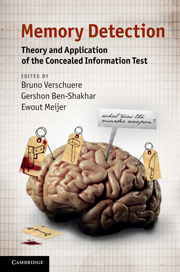Book contents
- Frontmatter
- Contents
- List of figures
- List of tables
- Notes on contributors
- Acknowledgments
- Part I Introduction
- Part II The laboratory: theoretical and empirical foundations of the Concealed Information Test
- 2 Detecting concealed information using autonomic measures
- 3 Detecting concealed information in less than a second: response latency-based measures
- 4 P300 in detecting concealed information
- 5 Detecting of deception and concealed information using neuroimaging techniques
- 6 New and old covert measures in the Concealed Information Test
- 7 Theory of the Concealed Information Test
- Part III Field applications of concealed information detection: promises and perils
- Part IV Conclusions
- Index
- References
7 - Theory of the Concealed Information Test
Published online by Cambridge University Press: 05 June 2012
- Frontmatter
- Contents
- List of figures
- List of tables
- Notes on contributors
- Acknowledgments
- Part I Introduction
- Part II The laboratory: theoretical and empirical foundations of the Concealed Information Test
- 2 Detecting concealed information using autonomic measures
- 3 Detecting concealed information in less than a second: response latency-based measures
- 4 P300 in detecting concealed information
- 5 Detecting of deception and concealed information using neuroimaging techniques
- 6 New and old covert measures in the Concealed Information Test
- 7 Theory of the Concealed Information Test
- Part III Field applications of concealed information detection: promises and perils
- Part IV Conclusions
- Index
- References
Summary
Overview: It is now well established that physiological measures can be validly used to detect concealed information. An important challenge is to elucidate the underlying mechanisms of concealed information detection. We review theoretical approaches that can be broadly classified in two major categories: theories that emphasize emotional–motivational factors, and those that emphasize cognitive factors. While emotional–motivational factors do not appear to be necessary for the detection of concealed information, they may enhance discriminability. Research with realistic setups is needed to examine whether emotional–motivational factors may exert a more prominent role in real-life concealed information tests compared with those performed under laboratory conditions. Empirical research largely supports the cognitive approaches and particularly Orienting Response (OR) theory, which can explain most of the research findings related to the Concealed Information Test (CIT). Future work needs to test whether OR theory holds under real-life circumstances, and whether OR theory needs to incorporate other processes (e.g., response inhibition) to fully account for the differential physiological responding to the relevant items in the CIT.
Discussions about polygraph tests typically focus on applied issues regarding the validity of various methods and measures. However, physiological detection of concealed information is also challenging from a theoretical perspective. Furthermore, a clear understanding of how a test works has an important practical value as it allows predicting the conditions, measures, and populations with which it will work. For example, how do psychopaths respond to the test? How many items are needed?
- Type
- Chapter
- Information
- Memory DetectionTheory and Application of the Concealed Information Test, pp. 128 - 148Publisher: Cambridge University PressPrint publication year: 2011
References
- 34
- Cited by



